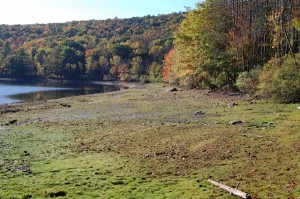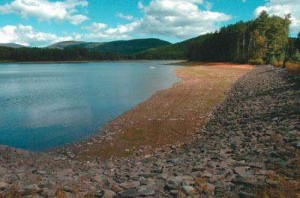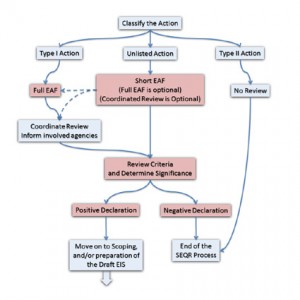By Rebecca Martin
I’d like to turn your attention for a moment to a critical aspect of the current SEQR process for the Niagara Bottling Company where the Town of Ulster Town Board is lead agent.
Have a look at page 1 in ‘Full Environmental Assessment Form’ (EAF) submitted to SEQR. In the ‘Brief Description of Proposed Action‘ where it says:
“The applicant (Enterprise Properties LLC) is proposing the construction of a water bottling facility on a 57.50 acre parcel of land at the end of Boices Lane. In addition, the project will involve the extension of municipal water and sanitary sewer services to the project site as well as natural gas and electric utilities….” etc.
Why is this significant?
The ‘ACTION’ in the EAF for SEQR submitted does not include the City of Kingston’s water source when it is a key component. Why wasn’t it included? Hard to say, but suspect it is because the City of Kingston has not yet made a decision. Given the EAF was submitted however without it is a concern in SEQR known as ‘segmentation‘.
The proposed ‘segmenting’ of the environmental review precludes a full environmental review of all of the potential impacts associated with the whole action, which includes the City’s decision to agree to sell its water and the Town of Ulster’s decision to allow the plant to be built and the DEC’s decision to allow water to be withdrawn from Cooper lake by the city of Kingston, and to allow Niagara to withdraw wastewater to the Lower Espous Creek.
The potential environmental impacts of all of these should be considered at the same time, through one environmental review overseen by one lead agency. That is what SEQR regulations strongly recommends: “Considering only part, or segment, of an overall action is contrary to the intent of SEQR.
What now? Could be any number of things. One of which may be that if the City of Kingston makes a decision to sell its water source to Niagara, a new SEQR process would be triggered.
It appears that the Town of Ulster has jumped the gun – big time. Outside of all of what is relayed here, in order to be a lead agency on a project this large where so many agencies and municipalities are involved would have required a letter from the Town of Ulster’s Town Board requesting to be lead agency. At which point, every single agency/municipality would need to give consent before proceeding. If there were a lead agency dispute, it would go before the Commissioner of the DEC for resolution. SEE 617: SEQR to understand authority and definitions.
As a reminder of what we are speaking of here, below is a photo of Cooper lake today taken by a local resident.




I have several questions.
First, what responsibility would Kingston and surrounding areas have in a drought condition? Would Kingston have financial liability?
Second, what entity would be responsible for creating the required infrastructure (for example resevoirs if needed, delivery systems, and treatment plants)? Who would be responsible for its upkeep?
Would Niagra insure that local workers be hired as much as available for skilled and non-skilled labor?
1. In order to answer your first question, one would have to know the extent of the contracts, decisions, agreements that exist out in the area. That would require first identifying them, and second if necessary to FOIL them. This is a very good question to address directly to the Kingston Water Board. They have a board meeting TOMORROW, 10/8 at 3:00pm. Please join us. Not certain if there will be a public comment portion, but we are certainly trying.
2. That is another question for the Water Board. Certainly, Kingston (in other words, the tax payer) is responsible for its infrastructure as would be true in any municipality. However, with a shared resource (other municipalities) in the case of emergencies – the partnerships perhaps allow for grants or other funding sources. That all needs to be understood.
3. All I can say to you about Niagara is that this ‘family business’ is actually a 300 million dollar business who sells their (our) water to places like Walmart and Costco. They are a corporation that generally see profit making a priority over all else. When you have companies come in from outside of the area, generally their allegiance to the community is far different from one who lives here. That’s the way it is in all cases that I have seen.
Would they insure that local workers be hired as much as available? They would say yes. What measurement exists for this? If they tell you that the only available jobs in the area are a couple dozen at $12 an hour after promising 120 jobs, what then? How does one know for certain if this is true, or if the numbers used up front were just all wrong?
If you google water bottling plant jobs you can find comments about working for this company. The most favorable comments I found were that working for Niagara was OK as a stop gap until finding something better. Mostly people reported lots of favoritism, lax safety standards, low wages and that sort of thing. How long is this industry going to be viable before such a plant becomes an obsolete abandoned eyesore. Bottled water should be denormalized, boycotted and banned.
Somebody please show me ONE community that has flourished from the sale of their water source to a Big Corporate bottling company.
NOT OUR WATER!!!.
The impact on the environment has the potential to be catastrophic. During drought conditions water could be purchased from Espous, which draws it water from the Hudson River, this additional drain on the Hudson may push the salt water line further north, threatening th aquatic life, plants, farming and the water supply available for Espous residents. Without potable water everything else is mute ..sustaining a healthy economy is impossible.
I see Rebecca doing her usual yeoman job of sorting out the approval process and responsible parties for the environmental approval of the commercial operation that is proposed. In very simplistic terms, the SEQR process seems to require that any negative impacts of the extraction be found “not too bad” from the perspective of near term human benefits, i.e. drinking water supply. There does not seem to be much emerging yet on the protection of ecosystem services from Cooper Lake and the reservoir, not unnecessarily depleting these as resources for tourism, agriculture, and stabilization of the local environment in the face of climate change. I thought that SEQR contained language on those benefits but have not had a chance to look. I am wondering more broadly what we know about the legality of selling public resources for commercial benefit, period. With all the controversies about mining and forestry on public lands, there has to be a body of law on this. Has anyone been in touch with Pace Land Use Law Center? I will keep an eye on this and try to figure out ways to be helpful.
Thanks, Melissa! Grateful to have you chime in. Been in touch with Pace. Lets gab whenever you have a chance.